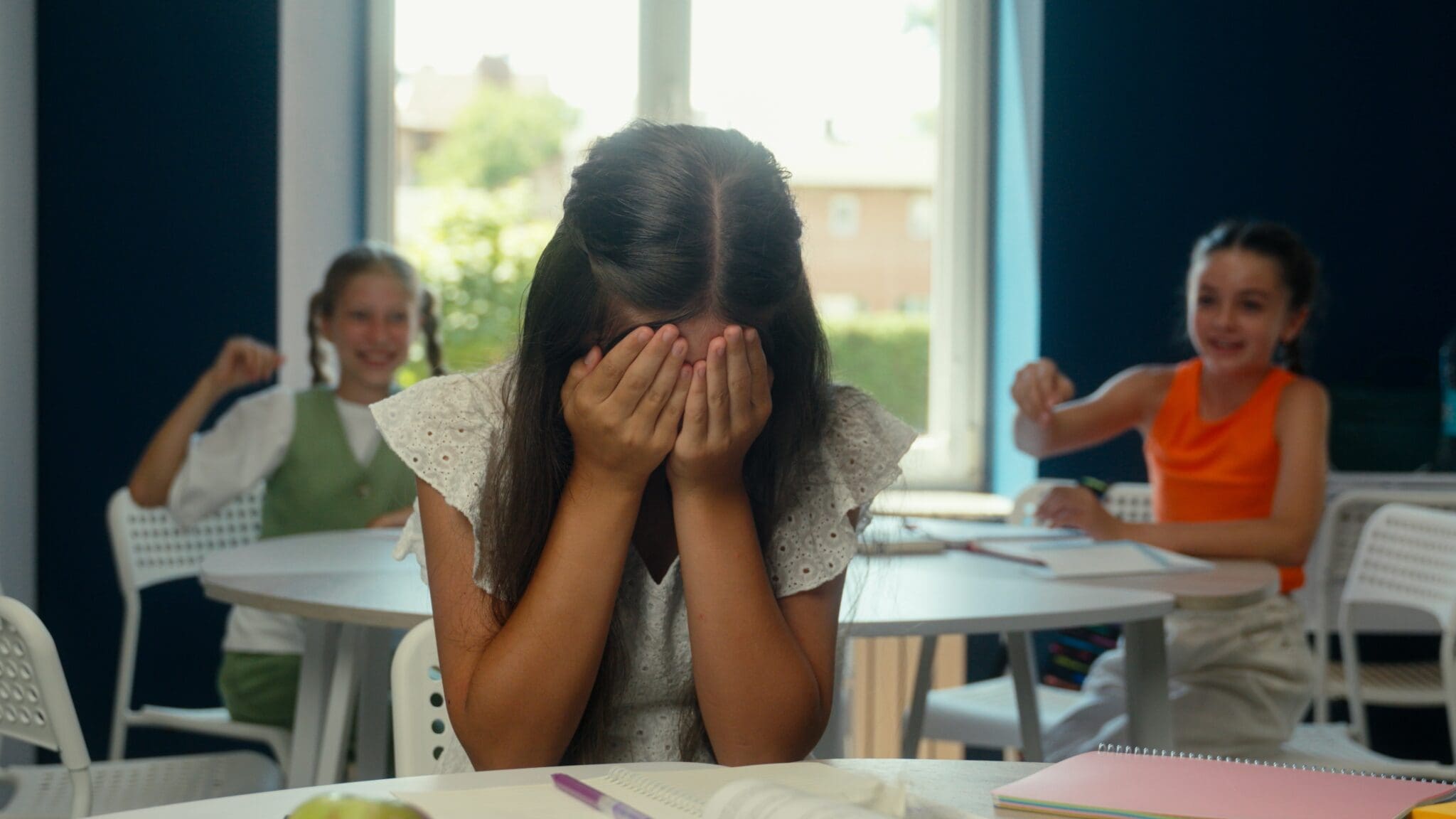In this article
Bullying is a serious issue across society. It affects people of all ages, backgrounds and settings. Its consequences can be lifelong, harming the well-being of victims and distorting the relationships and mental health of those who bully and those who witness it.
Simple “zero tolerance” slogans and one-off interventions, while well-meaning, rarely address the full problem. The causes of bullying are too complex.
To effectively prevent and reduce bullying, we need to examine the multifaceted roots – psychological, social, cultural and environmental – that allow this behaviour to surface.
This guide provides a deep exploration of the many contributing factors behind bullying and considers what communities, schools, workplaces and families can do to interrupt the cycle of harm.
What is bullying?
Bullying is best understood as a persistent pattern of behaviour, rather than a single act, intended to cause harm, fear or humiliation to a less powerful person or group. This pattern is what distinguishes bullying from ordinary conflict or one-time acts of rudeness.
The imbalance of power may be:
- Physical – Size or strength
- Social – Popularity or influence
- Situational – An adult to a child or a manager to a staff member
Bullying is not limited by age or setting. Adults may experience bullying in the workplace or community, just as children may encounter it at school, in clubs or online. In care homes, sports teams or even within family dynamics, bullying can manifest wherever there are hierarchies or group tensions.
Recognising that bullying can be both visible and hidden – sometimes subtle, silent or even unintentional – reminds us to be vigilant in all walks of life and to challenge harmful behaviours from the outset.

Types of bullying: Physical, verbal, social and online
- Physical bullying is often thought of as visible violence, but it can also include intimidation, gesturing or using physical presence to threaten or control. Victims may become hypervigilant or avoid certain spaces due to this threat.
- Verbal bullying has many layers. It can include sarcastic remarks, persistent criticism or “jokes” that single out and shame the victim. Over time, verbal bullying can erode a person’s self-esteem and change how they perceive themselves and the world.
- Social or relational bullying is often harder to identify and prove. Gossip, silent treatment, manipulating friendships or orchestrating exclusion from group activities all undermine a victim’s social support and can lead to chronic loneliness or anxiety. Social bullying is particularly damaging because humans are hard-wired to seek belonging and connection.
- Cyberbullying introduces new challenges. Harmful content can spread rapidly and remain online, sometimes reappearing long after the incident. The anonymity of digital platforms may embolden behaviour that would be unlikely face to face. Many victims describe feeling there’s “no escape”, as the harassment follows them beyond school or work, into their homes and personal lives.
The many different ways bullying can appear make it a complex issue to tackle effectively.
As digital culture continues to evolve, the line between online and offline bullying is increasingly blurred, with incidents in one sphere spilling over into the other.
What causes bullying?
Psychological motivations
Bullying rarely stems from a single cause. More often, it reflects a mix of personal factors and situational pressures.
- Striving for status or identity – For some, bullying is a way to carve out an identity, especially in environments where aggression or dominance is rewarded or where there’s fierce competition for attention.
- Relief from internal discomfort – People who struggle with shame, self-doubt or emotional pain may lash out as a temporary escape from their own discomfort.
- Coping with uncertainty – Bullying can be a way to cope with personal upheaval, such as parental divorce, bereavement or moving to a new environment. For someone feeling powerless, exerting control over others can feel reassuring, even if it’s harmful.
- A desire for predictability or routine – This is a less-discussed but significant driver. In chaotic or unpredictable environments, bullying can give people a sense of agency – albeit a destructive one.
Insecurity and low self‑esteem
Insecurity is often at the root of bullying, even if it’s well hidden beneath bravado or outward confidence. Some bullies may feel insignificant, ignored or undervalued in other parts of their lives and attempt to “level the playing field” by targeting those who seem even more vulnerable.
This sense of insecurity may stem from:
- Academic or workplace pressures that leave someone feeling inadequate or as if they fail to measure up
- Exclusion, loneliness or previous victimisation
- Difficulties with body image, speech or other differences that make somebody feel ashamed
It’s not uncommon for bullies to be experiencing their own mental health challenges or trauma. Bullying becomes their dysfunctional coping strategy, and aggression masks the pain beneath.
Interventions that focus on building true self-worth, teaching emotional regulation and offering meaningful recognition for positive behaviours are far more likely to succeed than punishment or exclusion.
Family environment and upbringing
Family is where early ideas about power, empathy and handling conflict are formed. Certain dynamics within the home can influence bullying behaviour, such as:
- Siblings as role models or rivals – When a person is bullied by their siblings and nothing is done about it, they may choose to bully others. Additionally, intense sibling rivalry can normalise aggressive behaviour and teach children that dominance earns rewards or attention from family members.
- Inconsistent discipline – Children may test boundaries through aggression when family rules are unclear or change often. They may learn that bullying is a surefire way to get what they want.
- Socioeconomic stress – Financial pressure, family breakdown or stressed parents can create a tense home environment where emotions run high. Frustration or insecurity may be displaced onto others, both inside and outside the home, sometimes showing up as bullying behaviour.
A family does not need to be overtly abusive to shape bullying behaviour. Sometimes, a lack of emotional connection, warmth or guidance can create a vacuum that’s filled by learned aggression or unhealthy peer influence.
Peer pressure and social dynamics
The social ecosystem outside the family – friends, classmates, colleagues – can shape bullying.
Peer influence is amplified in environments where:
- Cliques, groups or hierarchies are strongly defined and discourage outsider interaction
- Popularity or social capital is tied to aggressive or risky behaviour
- Adults are unaware of, or dismissive about, the nuances of social dynamics in youth or the workplace
- Gossip, secrecy or “in-jokes” become common ways to bond
People of all ages can find themselves swept up in bullying behaviour they wouldn’t typically condone simply to avoid social isolation or feel a sense of belonging. This can be very significant in the lives of children and teens. The fear of “missing out” or being ostracised can be intense. Similarly, in workplaces, silent bystanders may worry about job security or their standing in the group.
Long-term, proactive group interventions that encourage open dialogue, reward prosocial (kind) behaviour and actively challenge group norms can help turn the tide against bullying and build more supportive peer cultures.
Learned behaviour and media influence
Humans are social learners. We absorb lessons from those closest to us and the wider culture we’re exposed to. Expanding on this, some key issues include:
- Entertainment media – Popular shows, films and social media influencers sometimes glamorise or normalise bullying. They can make it appear humorous, clever or a sign of strength. When media isn’t counterbalanced by critical discussion, young viewers may internalise these messages.
- Workplace culture – In some industries or organisations, bullying is disguised as “banter”, “initiation”, or “just the way things are done”. Without clear leadership, new recruits or young staff may feel that aggression is necessary to fit in or get ahead.
- Algorithm-driven content – Social media users may be repeatedly exposed to extreme or hostile content, including “pile-ons”, shaming or mobbing. Harmful behaviour may seem commonplace or justified.
Promoting media literacy is critical, enabling children and adults alike to question the messages they receive and recognise manipulation, exaggeration or outright cruelty disguised as entertainment or commentary.
Power imbalances and the need for control
Power isn’t always obvious. It can be as subtle as a whisper campaign or as direct as physical intimidation.
- Structural inequalities – Bullying can be exacerbated by wider social inequalities – racism, sexism, homophobia, ableism – where prejudice and discrimination reinforce group power dynamics.
- Unaddressed privilege – Those in majority or more powerful groups may unconsciously (or deliberately) use bullying to maintain their advantages or marginalise outsiders.
- Resource control – In schools, workplaces or families, those with control over information, opportunities or decision-making processes may use that power to coerce, threaten or exclude others. They often do so in ways that are hard to prove or challenge.
Understanding the role of power, both individual and structural, is key to designing effective anti-bullying policies that address root causes – not just symptoms.
Mental health conditions linked to bullying behaviour
Let’s look at how mental health conditions could be linked to bullying. Remember: nuance is essential when bullying and mental health are discussed together.
- Co-occurring challenges – Many bullies also struggle with learning difficulties, past trauma or unrecognised neurodivergence, such as ADHD or autism. This can affect their social understanding, impulse control or emotional regulation.
- Stigma and support – Sometimes, children or adults who feel “different” or unsupported may lash out as a way to protect themselves from being targeted or singled out.
- Dual roles – People who bully often experience mental health problems themselves, including depression, anxiety and low self-esteem, especially when bullying becomes a cycle of harm.
Integrated support systems – where behavioural issues are addressed alongside emotional and learning needs – are far more likely to succeed than punitive approaches alone.

Understanding victim–perpetrator cycles
To break the cycle of bullying, we need to see individuals as more than just “bullies” or “victims”.
- Changing roles – Someone may be a victim in one environment (such as at home) and a perpetrator in another (such as at school or work). These shifting roles highlight the complexity of bullying and the importance of empathy, understanding and joined-up support across environments.
- Societal trauma – In communities or societies affected by violence, war or social upheaval, cycles of aggression can become embedded in the culture. Children may learn to bully as a defensive and adaptive strategy.
- Restorative practices – Programmes that focus on repairing relationships, understanding harm and teaching new skills, rather than just punishment, are key to ending victim–perpetrator cycles.
Consider the needs of both victims and perpetrators and recognise their shared humanity. This is how communities can create genuine change and lasting healing.
Warning signs of emerging bullying tendencies
Red flags, or warnings, will often precede bullying, enabling early intervention.
- Withdrawal from positive activities or friendships – A sudden change in interests or social group can signal underlying issues.
- Obsession with status or popularity – Constant talk about “who is in” or “who is out” may foreshadow exclusionary behaviour.
- Increasing secrecy – Refusing to discuss online activity, hiding phones or using coded language can indicate that the person has started to practice hidden bullying behaviour, especially in digital spaces.
In adults, a consistent pattern of undermining colleagues or controlling group narratives may point to more systemic bullying that needs to be addressed at an organisational level.
Why some bystanders become complicit in bullying
People don’t often consciously decide to be complicit in bullying. It’s typically a product of circumstance and fear. Here are some of the reasons why someone might become a bystander:
- Cultural silence – In some communities, speaking up against bullying is taboo, especially if it means challenging elders, leaders or those with status.
- Lack of skills – Many people simply don’t know what to do when they see bullying. They might worry that their intervention will make it worse.
- “Diffusion of responsibility” – In group settings, people may assume someone else will intervene, leading to inaction.
Bystander empowerment initiatives can help prevent complicity and make it more likely that people will step in to help. They may include role-plays, practical scripts and practising responses.

Preventative education and empathy building
Prevention starts with the everyday atmosphere – where kindness, respect and empathy are part of how people treat each other. Here are some strategies to consider:
- Multi-level engagement – Programmes that involve students, staff, parents and community leaders are most effective. When everyone is involved, messages are clearer and positive behaviours are more likely to stick.
- Continuous dialogue – Rather than annual anti-bullying assemblies, consider prioritising ongoing conversations and “check-ins”. Continuous dialogue makes respect and kindness part of everyday interaction.
- Celebrating positive behaviour – Recognising acts of kindness, inclusion and courage – in newsletters, awards or informal feedback – helps reinforce what is valued in the community.
- Supporting transitions – Key moments, such as starting secondary school or a new job, are times of vulnerability. Often, the risk of bullying increases during these periods. Proactive support and relationship-building can help newcomers integrate safely and confidently.
Ultimately, a climate of trust – where people feel safe to speak up, ask for help and make things right – makes bullying less likely to take hold, and easier to deal with when it does.
When you take the time to understand the full picture of bullying, along with all its complexity and context, you can respond with intelligence and compassion. Grounding prevention efforts in real insight gives you a better chance of building schools and workplaces where everyone can be themselves and learn, work and grow without fear.






